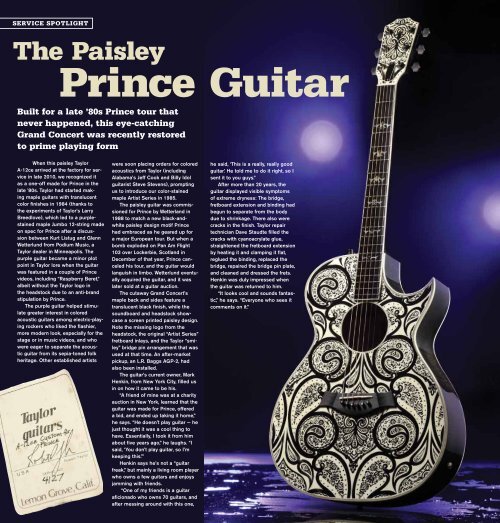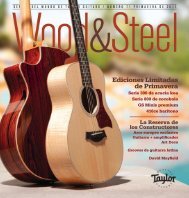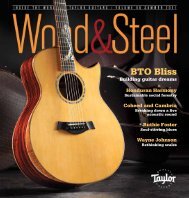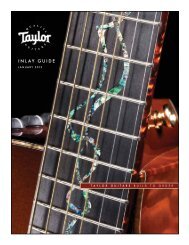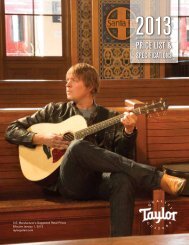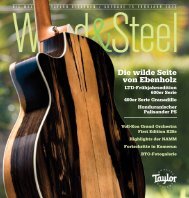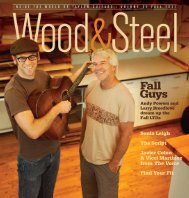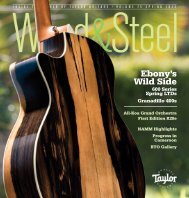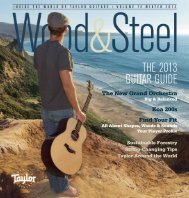Create successful ePaper yourself
Turn your PDF publications into a flip-book with our unique Google optimized e-Paper software.
SERVICE Spotlight<br />
The Paisley<br />
Prince Guitar<br />
Built for a late ’80s Prince tour that<br />
never happened, this eye-catching<br />
Grand Concert was recently restored<br />
to prime playing form<br />
When this paisley <strong>Taylor</strong><br />
A-12ce arrived at the factory for service<br />
in late 2010, we recognized it<br />
as a one-off made for Prince in the<br />
late ’80s. <strong>Taylor</strong> had started making<br />
maple guitars with translucent<br />
color finishes in 1984 (thanks to<br />
the experiments of <strong>Taylor</strong>’s Larry<br />
Breedlove), which led to a purplestained<br />
maple Jumbo 12-string made<br />
on spec for Prince after a discussion<br />
between Kurt Listug and Glenn<br />
Wetterlund from Podium Music, a<br />
<strong>Taylor</strong> dealer in Minneapolis. The<br />
purple guitar became a minor plot<br />
point in <strong>Taylor</strong> lore when the guitar<br />
was featured in a couple of Prince<br />
videos, including “Raspberry Beret,”<br />
albeit without the <strong>Taylor</strong> logo in<br />
the headstock due to an anti-brand<br />
stipulation by Prince.<br />
The purple guitar helped stimulate<br />
greater interest in colored<br />
acoustic guitars among electric-playing<br />
rockers who liked the flashier,<br />
more modern look, especially for the<br />
stage or in music videos, and who<br />
were eager to separate the acoustic<br />
guitar from its sepia-toned folk<br />
heritage. Other established artists<br />
were soon placing orders for colored<br />
acoustics from <strong>Taylor</strong> (including<br />
Alabama’s Jeff Cook and Billy Idol<br />
guitarist Steve Stevens), prompting<br />
us to introduce our color-stained<br />
maple Artist Series in 1985.<br />
The paisley guitar was commissioned<br />
for Prince by Wetterland in<br />
1988 to match a new black-andwhite<br />
paisley design motif Prince<br />
had embraced as he geared up for<br />
a major European tour. But when a<br />
bomb exploded on Pan Am Flight<br />
103 over Lockerbie, Scotland in<br />
December of that year, Prince canceled<br />
his tour, and the guitar would<br />
languish in limbo. Wetterlund eventually<br />
acquired the guitar, and it was<br />
later sold at a guitar auction.<br />
The cutaway Grand Concert’s<br />
maple back and sides feature a<br />
translucent black finish, while the<br />
soundboard and headstock showcase<br />
a screen printed paisley design.<br />
Note the missing logo from the<br />
headstock, the original “Artist Series”<br />
fretboard inlays, and the <strong>Taylor</strong> “smiley”<br />
bridge pin arrangement that was<br />
used at that time. An after-market<br />
pickup, an L.R. Baggs AGP-2, had<br />
also been installed.<br />
The guitar’s current owner, Mark<br />
Henkin, from New York City, filled us<br />
in on how it came to be his.<br />
“A friend of mine was at a charity<br />
auction in New York, learned that the<br />
guitar was made for Prince, offered<br />
a bid, and ended up taking it home,”<br />
he says. “He doesn’t play guitar — he<br />
just thought it was a cool thing to<br />
have. Essentially, I took it from him<br />
about five years ago,” he laughs. “I<br />
said, ‘You don’t play guitar, so I’m<br />
keeping this.’”<br />
Henkin says he’s not a “guitar<br />
freak,” but mainly a living room player<br />
who owns a few guitars and enjoys<br />
jamming with friends.<br />
“One of my friends is a guitar<br />
aficionado who owns 70 guitars, and<br />
after messing around with this one,<br />
he said, ‘This is a really, really good<br />
guitar.’ He told me to do it right, so I<br />
sent it to you guys.”<br />
After more than 20 years, the<br />
guitar displayed visible symptoms<br />
of extreme dryness: The bridge,<br />
fretboard extension and binding had<br />
begun to separate from the body<br />
due to shrinkage. There also were<br />
cracks in the finish. <strong>Taylor</strong> repair<br />
technician Dave Staudte filled the<br />
cracks with cyanoacrylate glue,<br />
straightened the fretboard extension<br />
by heating it and clamping it flat,<br />
reglued the binding, replaced the<br />
bridge, repaired the bridge pin plate,<br />
and cleaned and dressed the frets.<br />
Henkin was duly impressed when<br />
the guitar was returned to him.<br />
“It looks cool and sounds fantastic,”<br />
he says. “Everyone who sees it<br />
comments on it.”


